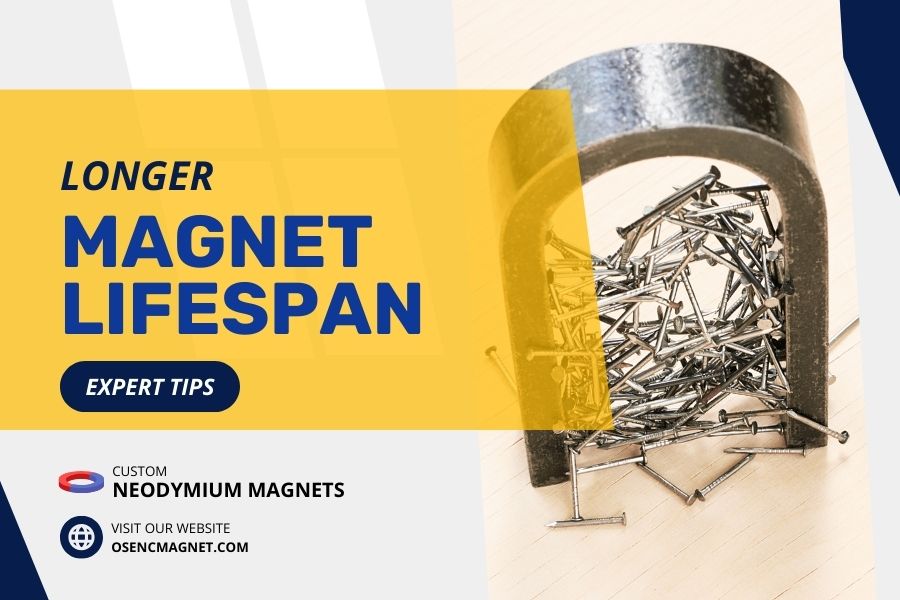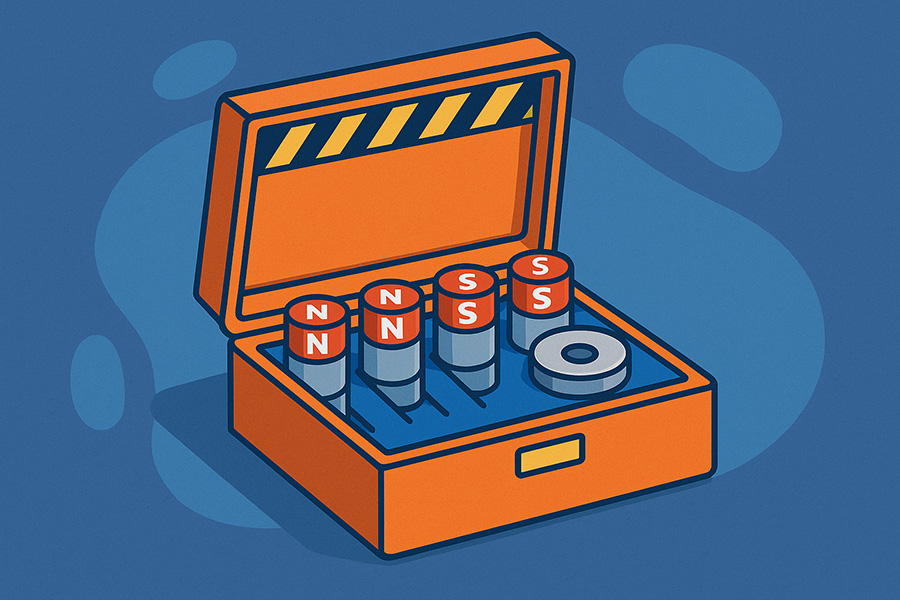Heat kills magnets.
This happens at a specific point called the Curie temperature.
Know this point. It matters for your projects.
Strong magnets like neodymium have lower heat limits than you might think.
- This post explains what Curie temperature is and why you should care.
- You’ll learn how heat affects different magnets.
- You’ll discover how to pick the right magnet for hot environments.
Let’s dig in.
What Is Curie Temperature?
Curie temperature is the maximum temperature at which a magnetic material keeps its permanent magnetic properties.
- When a magnet stays below this temperature, its tiny atomic “spins” line up in an orderly way. This alignment creates the magnetic field that makes magnets stick to your fridge.
- Heat the magnet above its Curie point, and those spins get jumbled up. The material becomes paramagnetic – basically, it stops being magnetic on its own.
Different materials have different Curie points:
- Iron: about 770°C
- Cobalt: about 1127°C
- Nickel: about 358°C
Neodymium magnets (the super strong ones) lose their magnetism around 310-400°C. That’s lower than ceramic magnets (450°C) and SmCo magnets (700-800°C).
As a magnet heats up toward its Curie point, it gets gradually weaker. Even well below the Curie point, heat makes magnets less powerful.
- The Curie temperature is just the final point where the magnetism completely vanishes.
Comparing Magnet Types and Temperatures
Different magnets handle heat differently. Here are the key temperature limits:
Alnico (Aluminum-Nickel-Cobalt)
- Curie temperature: 700-860°C
- Maximum operating temperature: 450-900°C
- Best for the hottest environments
Samarium Cobalt (SmCo)
- Curie temperature: 700-800°C
- Maximum operating temperature: 250-350°C
- Great for aerospace and high-heat industrial use
Ceramic/Ferrite
- Curie temperature: 450-460°C
- Maximum operating temperature: 250-300°C
- Common in many everyday applications
Neodymium (NdFeB)
- Curie temperature: 310-400°C
- Maximum operating temperature: 80-200°C (depends on grade)
Neodymium Grades
Neodymium magnets come in many grades that balance strength against heat tolerance. The grade appears as a letter-number code (like N35, N42, N52) sometimes followed by a suffix (M, H, SH, etc.).
The number shows the magnetic strength (higher = stronger magnet), and the letter code indicates temperature rating. Here’s a simple breakdown:
Standard Grades (N)
- N with no suffix: about 80°C max
- Very strong N50-N52 grades: usually max out at ~60°C
- Best for room-temperature use
Heat-Resistant Grades
- M = ~100°C max
- H = ~120°C
- SH = ~150°C
- UH = ~180°C
- EH = ~200°C
- VH (sometimes TH) = ~230°C
These enhanced grades contain additives (like Dysprosium) to boost heat stability.
Quick Selection Guide
- For normal use (≤50°C): N35-N52 (no suffix)
- For moderate heat (80-120°C): use M or H grades
- For high-heat motors (≥150°C): choose SH, UH, or EH
- For extreme heat (>300°C): consider SmCo or Alnico instead
Why Curie Temperature Matters (Especially for Neodymium Magnets)
Curie temperature sets the absolute heat limit for any magnet. Push past this point, and your magnet becomes just an ordinary piece of metal. This matters when designing anything that uses magnets – if they get too hot, they stop working.
- Magnets get weaker as they heat up.
The Curie point is the absolute max temperature. But the operating temperature is what really matters.
- This operating limit is always lower than the Curie point.
- You should focus on this lower limit when choosing magnets.
This is especially important for neodymium (NdFeB) magnets. These are the strongest permanent magnets we have, used in everything from motors to speakers to hard drives.
- But their Curie point sits at only about 320°C (around 610°F).
Here’s the real problem: neodymium magnets start losing strength at much lower temperatures.
- Some types begin to weaken at just 80°C – that’s not much hotter than a cup of coffee!
- For comparison, Samarium-Cobalt (SmCo) magnets have a much higher Curie point (around 700-800°C) and keep working well even at several hundred degrees.
That’s why they’re used in super-hot environments like aerospace and turbines.
Neodymium magnets can’t handle that kind of heat.
- In fact, most manufacturers recommend keeping them below 150°C, far below their Curie point.
Engineers must carefully control temperature to prevent these powerful magnets from becoming permanently weaker.
How Heat Affects Magnets
Temperature affects magnets in several important ways:
Reversible Loss (Below Operating Temperature)
Even below the maximum operating temperature, magnets experience a small temporary loss of strength.
- For neodymium magnets, this is around 0.08-0.12% for every 1°C rise in temperature.
This loss is reversible.
The magnet regains this strength when it cools back down.
Irreversible Loss (Above Operating Temperature)
When a magnet heats above its maximum operating temperature but stays below the Curie point, it suffers permanent damage.
The elevated temperature reverses the magnetization of some domains in the material.
Even after cooling down, the magnet remains weaker than before.
Complete Demagnetization (Above Curie Temperature)
When a magnet gets hotter than its Curie temperature, its magnetic domains lose all alignment.
- It stops being a magnet.
- It can’t attract paper clips, stick to your fridge, or do anything magnetic anymore.
- Cooling it back down doesn’t fix the problem.
Once a neodymium magnet heats beyond ~320°C and then cools, it stays demagnetized unless you remagnetize it with a strong magnetic field.
Extreme Heat Damage
If you keep heating even higher, things get worse.
Neodymium magnets start to fall apart around 900-1000°C.
At this point, they literally disintegrate or melt, and you can’t get their magnetic properties back.
But hitting these extreme temperatures is rare outside a lab – the magnet would burn or oxidize first.
- The important point is that even briefly exceeding the Curie temperature is usually enough to ruin a magnet’s usefulness.
Real-World Applications
Different magnets serve different industries based on their temperature needs. Here’s how they’re used:
Automotive
High-temperature magnets like SmCo and alnico power sensors, electric motors, and under-hood components.
They must handle the extreme heat near engines and exhaust systems.
Neodymium magnets with special high-temp grades also appear in many modern electric vehicles.
Aerospace
SmCo magnets work well in aerospace applications. They maintain their properties up to 350°C.
We find them in aircraft motors, generators, and actuators that experience extreme temperatures.
Their stability at both high and low temperatures makes them ideal for the harsh conditions of flight.
Industrial Motors
Alnico magnets (operating up to 450-900°C) and SmCo magnets enable high-temperature electric motors and generators.
These powerful magnets keep working without risk of demagnetization in hot factory environments.
Large industrial equipment often uses these heat-resistant magnets to avoid failures and downtime.
Sensors and Controls
Magnetic sensors and switches using high-Curie-point magnets work reliably in hot industrial settings.
They provide consistent readings and operation even as temperatures fluctuate.
Microwave Devices
Certain microwave tubes and devices need strong magnetic fields at high operating temperatures.
They use magnets with Curie points well above their operating temperatures for stable performance.
Consumer Products
Many everyday gadgets use neodymium magnets when they need serious strength in a small space.
Headphone speakers, smartphone vibration motors, and hard drive parts all contain these magnets.
These devices mostly run near room temperature, so standard neodymium grades (N35-N52) work fine.
Medical Applications
In medicine, magnets show up in hearing aids, MRI components, and some surgical tools.
These need magnets that are safe for the body and stable in warm, wet conditions.
Gold or special Parylene coatings protect these magnets from corrosion and make them biocompatible.
Hobbyist Projects
DIY enthusiasts use neodymium magnets for homemade robots, craft projects, or science demos.
These usually operate at room temperature, so people pick strong grades like N42 or N52.
The key is properly matching the magnet type to your application’s temperature requirements.
Summary
Curie temperature is the fundamental heat limit for any magnet. Neodymium (NdFeB) magnets have a relatively low Curie point (~320°C), which means we need to be careful about heat.
By understanding Curie temperature and the operating limits of neodymium magnets, both engineers and hobbyists can choose the right magnet and make sure it stays strong and reliable in its intended environment.



